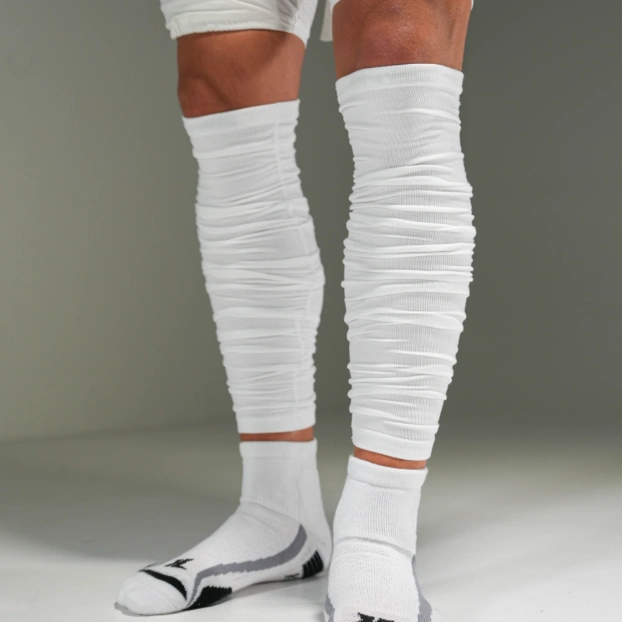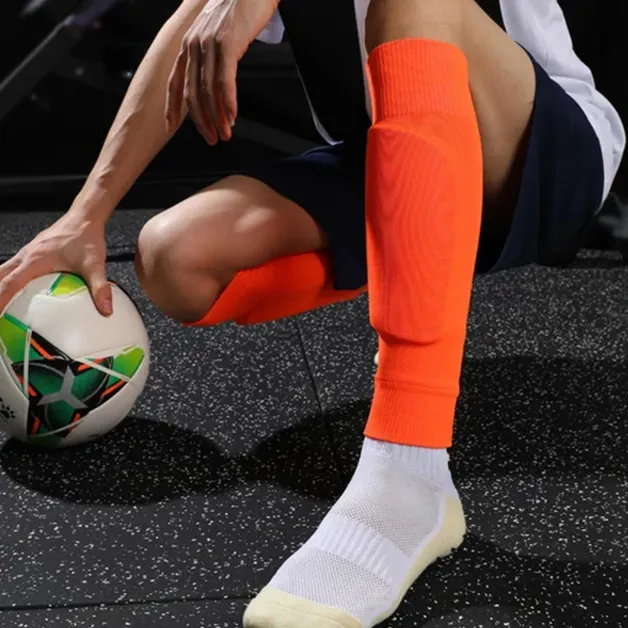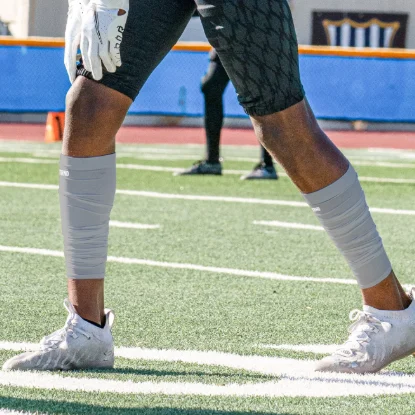Introduction: Beyond Fashion – The Functional Revolution of Football Leg Sleeves

Football leg sleeves have transcended their initial perception as mere fashion accessories to become essential performance equipment for players at all levels. These specialized compression garments have gained widespread adoption across professional leagues and amateur circuits alike, with players recognizing their multifaceted benefits that extend far beyond aesthetic appeal. Modern football leg sleeves represent the intersection of sports science, material innovation, and athletic performance optimization. This comprehensive guide explores the crucial roles these garments play in enhancing player capabilities, preventing injuries, and supporting recovery processes that keep athletes performing at their peak throughout demanding seasons.
The Science of Compression Technology
How Graduated Pressure Enhances Blood Flow
The fundamental principle behind football leg sleeves lies in their graduated compression design, which applies variable pressure along the leg with greater compression at the ankle gradually decreasing toward the knee. This pressure gradient works with the body’s natural circulatory system, enhancing venous return and improving blood flow back to the heart. Enhanced circulation delivers more oxygen to working muscles while efficiently removing metabolic waste products like lactic acid. Research has demonstrated that this improved blood flow can delay fatigue onset during high-intensity activities, allowing players to maintain peak performance for longer durations during matches and training sessions.
Muscle Stabilization and Reduced Vibration
Beyond circulatory benefits, compression technology significantly reduces muscle vibration during high-impact activities like sprinting, cutting, and jumping. These repetitive movements create microscopic muscle oscillations that contribute to fatigue and potential tissue damage over time. Football leg sleeves provide a stabilizing external pressure that minimizes these vibrations, resulting in more efficient muscle function and reduced energy expenditure. This stabilization effect is particularly beneficial during the explosive movements characteristic of football, helping players maintain proper form and mechanical efficiency throughout extended periods of play.
Performance Enhancement Benefits
Temperature Regulation in Varying Conditions
Modern football leg sleeves incorporate advanced thermoregulation technologies that help maintain optimal muscle temperature regardless of environmental conditions. In cold weather, the compression layer provides gentle insulation, trapping body heat close to the muscles without causing overheating. This helps maintain muscle elasticity and responsiveness, reducing the risk of strains that often occur when muscles are too cold.
On the flip side, when playing in hot climates or under intense sunlight, some leg sleeves are engineered with cooling mesh zones and moisture-wicking yarns. These sleeves rapidly pull sweat away from the skin, promoting evaporation and creating a natural cooling effect. This not only improves comfort but also helps regulate heart rate and energy expenditure, enabling players to maintain peak physical performance even during heat-intense match conditions.
Psychological Edge: Confidence and Focus
The performance benefits of football leg sleeves extend beyond physiological effects to include significant psychological advantages. Many players report improved proprioception—the body’s internal sense of spatial awareness—when wearing snug-fitting sleeves. This heightened sense allows for faster foot placement adjustments, sharper turns, and more confident handling of the ball.
Moreover, the act of wearing uniform, supportive gear can trigger a mental shift into a game-ready mindset. The secure feeling around the legs contributes to reduced anxiety about minor knocks or awkward tackles. This psychological assurance allows players to be more assertive in high-pressure scenarios, from chasing down fast breaks to committing fully in defensive situations.
Injury Prevention Through Muscle Stabilization
Another overlooked benefit is muscle stabilization. Compression sleeves apply graduated pressure that reduces muscle oscillation—the small, rapid vibrations that occur during intense activity. Over time, minimizing this vibration helps delay muscle fatigue, reduces the buildup of lactic acid, and lowers the likelihood of micro-tears. This directly correlates with improved endurance during matches and fewer injuries across a season.
| Benefit Area | Description |
|---|---|
| Temperature Regulation | Maintains muscle warmth in cold; cools in heat via moisture-wicking materials. |
| Psychological Edge | Enhances confidence, focus, and body awareness through supportive fit. |
| Muscle Stabilization | Reduces muscle vibration and fatigue; supports endurance and injury prevention. |
Injury Prevention Capabilities
Protection Against Impact and Abrasion
Football’s physical nature inevitably leads to contact situations where legs are vulnerable to impacts, tackles, and playing surface abrasions. Quality football leg sleeves provide a protective barrier that absorbs and distributes impact forces while shielding the skin from turf burns and abrasions. Some advanced models incorporate strategic padding or reinforced zones at common impact points without compromising flexibility or adding significant weight. This protection is especially valuable for players returning from injury who need additional confidence during their reintegration to full-contact play. A layer of durable knit fabric can also help prevent cuts or skin irritation during aggressive tackles or when sliding across artificial turf.
Muscle Strain Reduction Through Support
The supportive compression provided by football leg sleeves helps maintain proper muscle alignment during dynamic movements, reducing the risk of strains and pulls that commonly sideline players. By providing external support to major muscle groups like the calves and quadriceps, sleeves help prevent overextension and improper loading patterns that can lead to acute or chronic injuries. This supportive function is particularly beneficial during periods of fatigue when technique naturally deteriorates, offering a safeguard against the injuries that frequently occur in the closing stages of intense competition.
Stabilization of Joints and Tendons
Beyond muscles, leg sleeves also assist in stabilizing joints and tendons. This added control is particularly important for players prone to ankle or knee discomfort, as sleeves reduce micro-movements that strain ligaments and connective tissues. Compression can lessen vibration and shock through the lower leg with each stride, which helps mitigate tendon inflammation and overuse injuries. Consistent use during training and matches may support long-term joint health, particularly for athletes in high-impact positions.
Recovery Acceleration Features
Post-Exercise Recovery Enhancement
The recovery benefits of football leg sleeves extend well beyond the final whistle. Many players wear compression sleeves not just during games but also in post-exercise settings to support faster muscle repair. Graduated compression helps stimulate circulation, ensuring that oxygen-rich blood reaches fatigued muscles while promoting the removal of lactic acid and other waste byproducts. This enhanced circulation reduces muscle vibration and inflammation, which are primary contributors to soreness after physical exertion.
Some athletes choose leg sleeves with higher compression ratings—typically 20–30 mmHg—for recovery sessions. These options are specifically designed to support muscle repair without restricting comfort. Worn during cool-downs, travel, or even during sleep, recovery-specific sleeves can significantly reduce the severity of delayed onset muscle soreness (DOMS), helping athletes maintain performance levels throughout back-to-back match days or congested training periods.
Injury Rehabilitation Support

For players recovering from calf strains, shin splints, or minor contusions, football leg sleeves can serve as an effective support tool during rehabilitation. Medical-grade compression sleeves assist in managing swelling and inflammation by applying consistent pressure to the injured area. This helps control fluid buildup and reduces discomfort, especially during early recovery phases.
Additionally, the proprioceptive benefits—enhanced body awareness and limb coordination—are valuable during physical therapy. Players relearning movement after injury benefit from the gentle support and stabilization these sleeves provide. Many recovery-grade sleeves also include reinforced zones targeting vulnerable muscle groups or injury-prone areas, offering focused compression where it matters most. When used under professional guidance, compression sleeves become more than just gear—they act as tools that actively facilitate a safe and steady return to peak condition.
| Use Case | Recommended Compression | Purpose | Key Benefits |
|---|---|---|---|
| During Matches | 15–20 mmHg | Muscle support and circulation boost | Reduced fatigue, improved blood flow, injury prevention |
| Post-Training Recovery | 20–30 mmHg | Enhanced muscle recovery | Faster lactic acid removal, less soreness |
| Injury Rehabilitation | 20–30 mmHg (medical grade) | Swelling control and tissue stabilization | Supports healing, reduces inflammation, boosts proprioception |
| Travel or Rest Periods | 15–20 mmHg | Circulatory maintenance | Prevents fluid retention, supports muscle health |
Material Technology Advancements
Moisture Management and Antimicrobial Properties
The evolution of fabric technology has dramatically improved the functionality of football leg sleeves. Advanced moisture management systems utilize hydrophobic fibers that actively transport sweat away from the skin to the garment’s outer surface, where it can evaporate efficiently. This wicking action helps maintain dry skin contact, reducing chafing and discomfort during extended wear. Premium sleeves also incorporate antimicrobial treatments that inhibit bacteria growth, preventing odor development and extending the usable life of the garment between washings. These hygiene-enhancing properties are particularly valuable during tournament situations where multiple matches occur over consecutive days. They also contribute to a more professional image for players and teams alike, especially in competitive or televised environments.
Durability Factors in High-Performance Fabrics
The demanding nature of football requires leg sleeves that can withstand intense use without losing their compressive properties or structural integrity. Leading manufacturers like Max Hosiery have pioneered high-performance fabric blends that maintain consistent compression levels even after repeated washing and wearing cycles. These durable materials typically combine synthetic elastomers with natural fibers to create optimal stretch recovery and resilience. The most advanced options utilize multi-directional stretch construction that allows freedom of movement while ensuring the sleeve returns to its original shape, maintaining consistent compression delivery throughout the garment’s lifespan.
Breathability and Heat Regulation
In hot climates or during high-intensity matches, ventilation becomes a critical factor. New-generation leg sleeves are designed with mesh zones or perforated fabric panels in targeted areas such as the calf or behind the knee. These zones encourage airflow, help release trapped heat, and maintain a comfortable skin temperature. As a result, athletes are better able to maintain performance levels without discomfort or overheating, particularly during peak exertion.
Selection Considerations for Players
Position-Specific Requirements and Features
Each on-field role places distinct stresses on the legs, so sleeve selection should align with position-related demands. Defenders engage in frequent tackles, blocks, and ground challenges; they benefit from sleeves featuring reinforced panels over the shins and extra abrasion resistance to withstand scrapes. Midfielders cover extensive distances during a match, making lightweight, breathable compression sleeves ideal—they improve circulation and reduce muscle fatigue without weighing players down. Forwards rely on explosive sprints and rapid changes of direction, so they often choose sleeves with targeted support zones around the calf and quadriceps to stabilize muscle groups during sudden acceleration. Goalkeepers need enhanced flexibility for diving, lunging, and lateral shuffles; sleeves designed for keepers typically include additional padding around the knee and flexible, stretchable fabric that does not restrict movement.
Sizing and Fit: The Critical Factors
Proper sizing is the most important aspect of sleeve effectiveness. Sleeves that are too tight can constrict blood flow, leading to numbness or cramping, while loose-fitting sleeves won’t deliver sufficient compression or may slip down during play. To find the right fit, players must measure their calf and thigh circumferences at the widest points and record leg length from ankle to mid-thigh or knee, depending on sleeve length. Many athletes select based on general clothing size, which often results in sleeves that bunch behind the knee or slide down toward the ankle. The ideal sleeve should feel snug and supportive without causing discomfort—there should be no pinching at the hem, no excessive wrinkling, and no shifting when running or jumping.
Material and Durability Considerations
Beyond fit and position-specific design, the sleeve’s material composition influences performance and longevity. High-quality nylon-spandex blends offer strong elasticity, moisture-wicking properties, and quick-dry capabilities—essential for matches played in varying weather. Some players prefer sleeves with reinforced stitching and double-layered fabric over high-wear zones to avoid premature tearing. For those playing on turf or artificial grass, abrasion-resistant weaves prevent the sleeve from wearing thin. Finally, UV-resistant fabrics protect legs during sunny, outdoor fixtures and maintain colorfastness through multiple washes.
Maintenance Best Practices
Washing and Care for Longevity
Proper maintenance significantly extends the functional lifespan of football leg sleeves. Hand washing in cold water with mild detergent preserves elasticity and compression properties, while machine washing should utilize gentle cycles and protective mesh bags. Players should avoid fabric softeners and bleach products that degrade elastic fibers and compromise compression delivery. Air drying flat or on a non-metal hanger prevents shape distortion, as high-heat drying can permanently damage the advanced materials. Establishing a rotation system with multiple pairs reduces wear frequency and extends overall durability while ensuring clean sleeves are always available for training and matches.
When to Replace: Recognizing Wear Indicators
Even with proper care, football leg sleeves eventually lose their compressive properties and require replacement. Key indicators include visible stretching at rest, decreased tension when worn, or areas of thinning fabric. Most high-quality sleeves maintain optimal compression for approximately 40-60 wearing cycles before noticeable degradation occurs. Players should periodically assess compression by comparing the feel of newer sleeves to older ones, replacing items when the difference becomes apparent. This proactive replacement approach ensures consistent performance benefits rather than waiting for complete compression failure.
Professional Implementation Strategies
How Elite Teams Integrate Compression Programs
Professional football clubs have developed sophisticated compression protocols that extend beyond match-day usage. Many elite teams implement comprehensive programs that specify different compression levels for training, competition, travel, and recovery phases. These structured approaches often include pre-match activation routines while wearing sleeves, specific post-match recovery periods with higher compression ratings, and travel protocols that address circulatory challenges during long journeys. By systematically integrating compression garments throughout the weekly cycle, professional teams maximize the cumulative benefits while monitoring individual player responses to optimize personalization.
Customization Options for Team Identity
Beyond functional benefits, football leg sleeves offer opportunities for team identity expression through customization. Professional and amateur teams alike utilize branded sleeves featuring team colors, logos, and sponsor integration that create visual cohesion while delivering performance benefits. Some organizations implement color-coding systems that indicate player positions or squad designations, adding practical communication value during training sessions. These customization options, available through suppliers like Max Hosiery, allow teams to maintain professional appearance standards while benefiting from the performance advantages compression technology provides.
Conclusion: Integrating Sleeves into Your Football Approach
Football leg sleeves have evolved from optional accessories to essential performance equipment, offering scientifically validated benefits that address multiple aspects of athletic performance and wellbeing. The comprehensive advantages—from enhanced circulation and muscle support to temperature regulation and recovery acceleration—make them valuable tools for players seeking marginal gains in their competitive approach. By understanding the specific benefits, selection considerations, and maintenance requirements outlined in this guide, players can make informed decisions about incorporating compression technology into their football preparation and performance strategies.

As material science and sports performance research continue advancing, football leg sleeves will likely see further refinements that enhance their already impressive functionality. Players who embrace these innovations position themselves at the forefront of performance optimization, utilizing every available advantage to elevate their game. Whether you’re a professional seeking recovery advantages or an amateur looking to enhance performance and protection, quality football leg sleeves represent a relatively small investment with potentially significant returns in performance capability, injury prevention, and career longevity.
Ready to explore all our performance sock and sleeve offerings? Visit our website to view the full product gallery and discover how Max Hosiery can craft custom compression solutions tailored to your team’s needs.
FAQ Section
Do football leg sleeves actually improve performance or are they mostly psychological?
Research confirms both physiological and psychological benefits, with studies showing measurable improvements in circulation, muscle stabilization, and proprioception, while the confidence boost provides additional performance enhancement through improved decision-making and commitment to challenges.
How long should football leg sleeves be worn after matches for optimal recovery?
For optimal recovery benefits, wear compression sleeves for 2-3 hours post-activity, though some athletes benefit from overnight use with slightly reduced compression levels that maintain circulation benefits without restricting movement during sleep.
Can football leg sleeves help with existing injuries or only prevention?
While primarily preventative, certain medical-grade compression sleeves are specifically designed for injury management, helping reduce swelling, provide structural support, and enhance proprioception during rehabilitation phases when used as part of a comprehensive treatment plan.
Are there different types of football leg sleeves for different weather conditions?
Yes, season-specific sleeves exist with varying thicknesses and materials—lightweight, breathable options for hot conditions focus on cooling and moisture management, while cold-weather variants provide insulation while maintaining compression benefits.
How tight should football leg sleeves feel when properly fitted?
Properly fitted sleeves should feel noticeably compressive without causing discomfort, numbness, or color changes in extremities; you should be able to slide two fingers under the top band while feeling resistance, indicating appropriate graduated compression.
